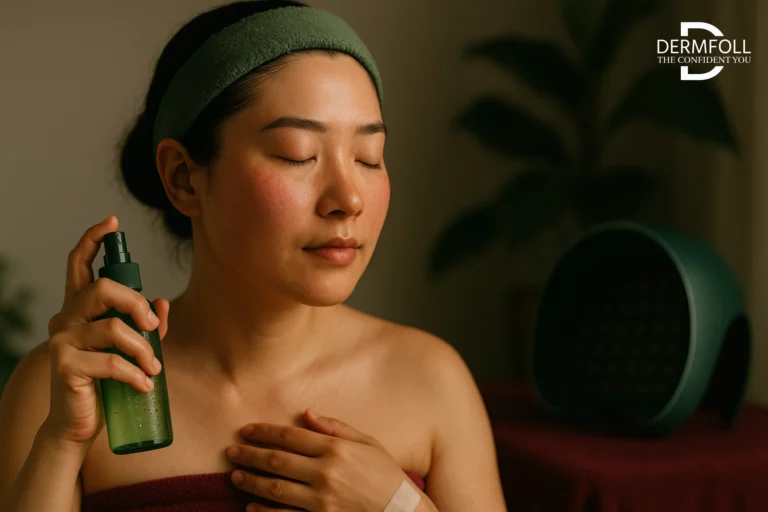Let’s face it—choosing the right skin treatment can feel as overwhelming as deciding between a turbo-powered blender and a hand mixer. Both get the job done, but their strengths lie in different places. That’s exactly how it is with Monopolar RF vs. Bipolar RF—two cutting-edge technologies making waves in skin tightening, contouring, and rejuvenation.
Whether you’re dreaming of a more sculpted jawline, smoother thighs, or rejuvenated skin, understanding what sets these two apart is key. And if you’re an investor eyeing the latest skincare breakthroughs, knowing the science behind the buzzwords can be your secret weapon.
Welcome to DERMFOLL. Here’s what we’ll unpack together:
- The science behind Monopolar RF vs. Bipolar RF and how they work their magic.
- Clear, practical differences to help you decide which option delivers the best results for your goals.
- Real-world success stories and why these tools are the rising stars of dermatology.
By the end, you won’t just know about Monopolar RF vs. Bipolar RF—you’ll feel empowered to make decisions that match your skincare (or business) goals. Ready? Let’s dive in and demystify the magic.
How Do Monopolar and Bipolar RF differ in Area Of Skin Treatment? Monopolar RF vs. Bipolar RF
Monopolar RF: Predominantly used for body contouring and deeper skin tightening, monopolar RF delivers energy deep into the tissues, often reaching subdermal layers. It is effective for treating large areas such as the abdomen, thighs, and other body parts requiring significant skin tightening and fat reduction. It requires a grounding pad to complete the circuit.
Bipolar RF: Primarily used for facial treatments and localized skin rejuvenation, bipolar RF targets more superficial layers of the skin. It is ideal for fine lines, wrinkles, and improving skin texture on areas like the face, neck, and décolletage.
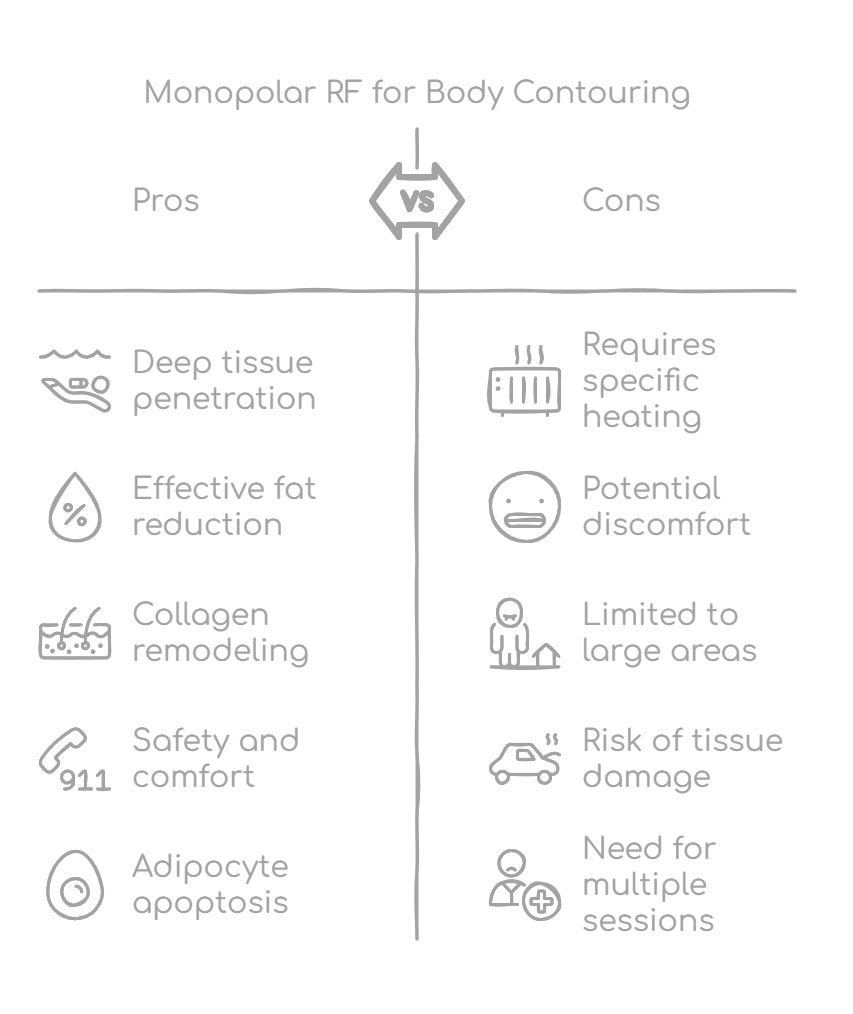
How Does Monopolar Radiofrequency Excel in Body Contouring and Skin Firming
Monopolar radiofrequency (RF) therapy is highly effective for treating skin laxity and body contouring. This is especially true for larger regions like the belly, thighs, and back.
What differentiates it is its deep tissue penetration, which increases collagen synthesis. While targeting fatty tissue as well. This dual action firms the skin while simultaneously shaping the physique.
How it works
When skin is heated to 52-55°C with monopolar RF, it produces collagen and activates heat-shock proteins (HSPs). Specifically HSP-47, a protein required for collagen type I synthesis.
Furthermore, this heat stimulates adipocyte apoptosis, which is the gentle destruction of fat cells. Occurring with no injury to the surrounding tissues. This combo produces visible benefits after repeated sessions—think of it as a gym membership for your skin, minus the squats!
The Case in Action
In a study, mentioned in the source section below, participants used monopolar RF to tighten their skin after losing weight.
Participants reported smoother, firmer abdominal skin following three treatments spaced one month apart. As well as measurable improvement in elastography (skin firmness scans).
Why the large areas?
The technology is ideal for large areas like the back or chest because it provides uniform heat. Which is vital for consistent outcomes. This feature also makes it a popular choice for postpartum or post-weight-loss skin laxity. As it efficiently addresses strained collagen strands.
Why Is Monopolar RF Generally Avoided for Facial Treatments
However, the deep penetration of monopolar RF may be excessive for facial treatments. Bipolar radiofrequency devices are generally favored for delicate areas around the eyes. Which requires more precise control. These devices provide energy control that is more appropriate for tiny, sensitive locations.
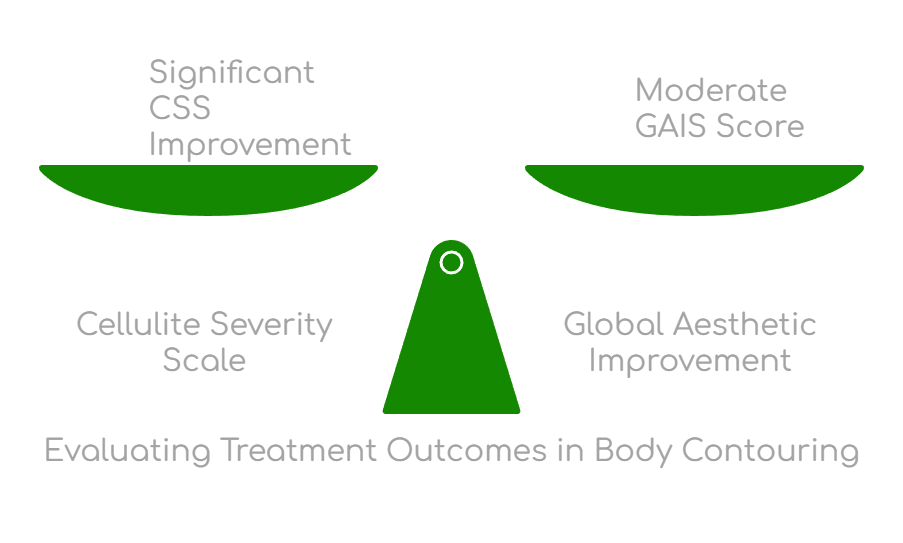
What Makes Bipolar RF the Best Choice for Delicate Skin Areas?
Bipolar radiofrequency (RF) technology is particularly effective on delicate, complicated parts of the face and in small treatment zones. Unlike monopolar RF, bipolar RF provides regulated, targeted energy that remains within the dermis. This makes it the preferred choice for treating fragile skin with precision and safety.
Why Bipolar RF is Effective for Facial Treatments
Bipolar RF is designed for sensitive areas such as the under-eyes, cheeks, and jawline. It prevents deep tissue penetration, reducing the risk of overheating and injury to surrounding tissues.
Clinical studies have demonstrated that patient satisfaction is high, particularly in under-eye treatments. Supporting its precise energy delivery and low downtime.
Bipolar RF treatments work particularly effectively for crow’s feet, forehead wrinkles, and nasolabial folds. Which are common signs of aging.
Heating the dermis causes collagen contraction and remodeling, which results in firmer, smoother skin. Patients frequently see visible suppleness and wrinkle reduction after just a few sessions.
Why Is Bipolar RF Ideal for Treating Scars and Small Areas?
Bipolar RF is very effective for scars, stretch marks, and tiny treatment areas such as the hands or knees. It stimulates neocollagenesis (new collagen production) in specific locations. Increasing texture and appearance without damaging surrounding tissues.
Delicate zones deserve precision.
Bipolar RF works very well on the neck and décolleté. Its capacity to precisely distribute energy to shallow layers protects and rejuvenates the skin. Patients usually comment on the low discomfort and short recovery times, making it a reliable option for neck and décolleté treatments.
The Safety Edge
The localized energy delivery of bipolar RF is about peace of mind. Patients routinely report faster recovery times and less discomfort. Reinforcing its position as the top choice for focused skin care treatments.
Bipolar RF technology is a versatile and successful tool for treating tiny lines and scars. Its precision and safety make it crucial for facial and localized therapies.
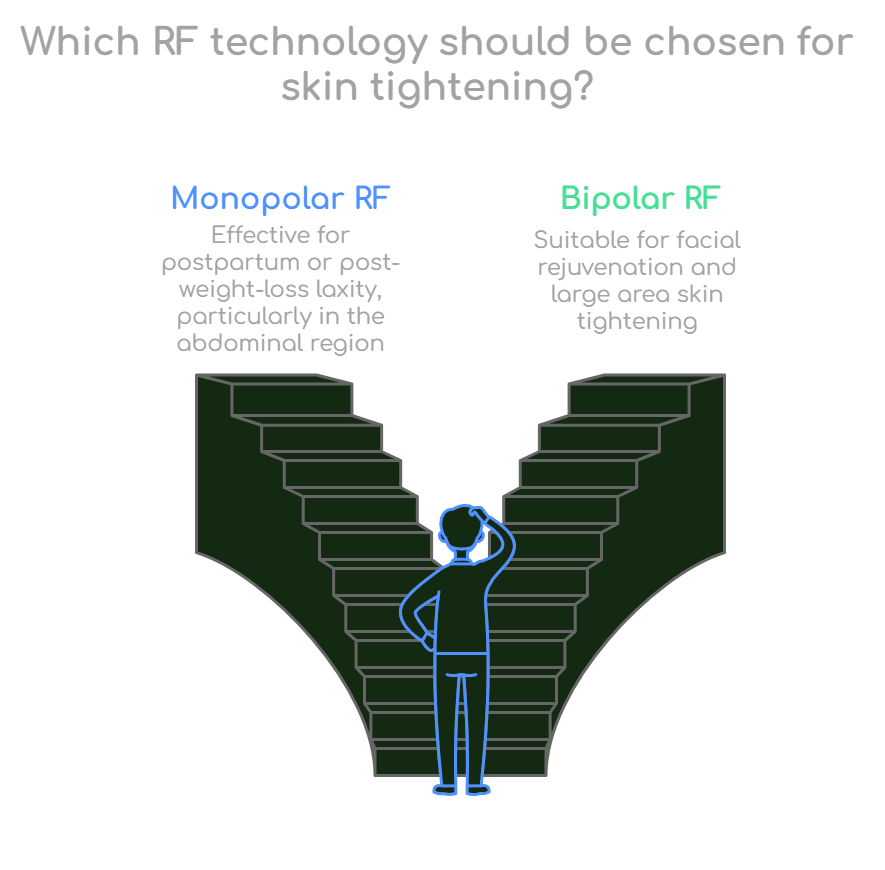
How Are RF Treatments Used Differently for Men and Women?
For Men
Abdominal, Chest, and Jawline Contouring
Men frequently use RF treatments to refine the belly and chest, increase muscle definition, and sculpt the jawline.
Monopolar RF is often utilized for deeper fat removal in certain areas, but bipolar RF is chosen for skin tightening, which results in a more defined appearance.
Post-weight-loss skin tightening
Loose skin on the back and arms is a typical complaint among males following major weight loss. RF treatments offer a non-invasive alternative to surgical procedures such as brachioplasty.
By compressing collagen fibers and stimulating new collagen formation, RF effectively tightens sagging skin while minimizing downtime.
Men looking for a practical, less invasive alternative are drawn to RF for its safety and convenience, as it avoids scars and the extended recovery periods associated with surgical procedures.
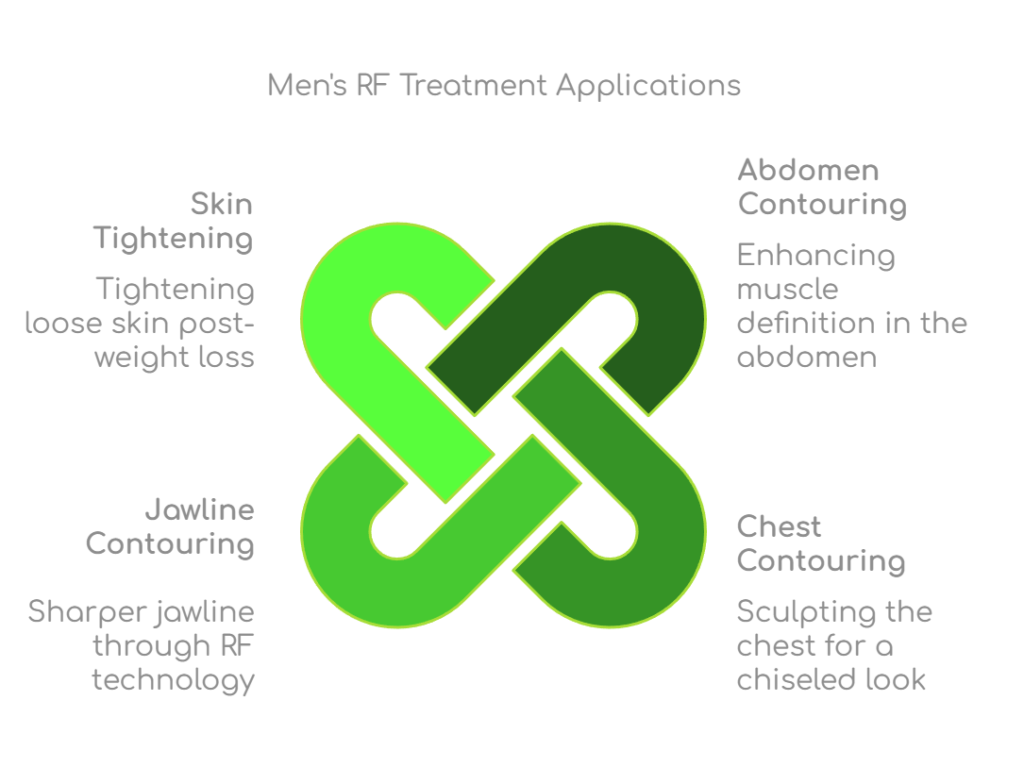
For Women
Face, Thighs, and Décolleté Rejuvenation
For women, RF treatments often target the face, thighs, and décolleté to address anti-aging concerns and enhance contouring. Bipolar RF is the star here, offering precision for fine lines, improved texture, and firmer skin without penetrating too deeply.
Why It Works:
Bipolar RF stimulates collagen in the dermal layer, smoothing wrinkles and tightening skin with minimal recovery time. Women also appreciate its ability to deliver natural-looking results without appearing overdone.
Stretch Mark Reduction in the Abdomen or Hips
Post-pregnancy or weight-related stretch marks are a frequent focus for RF treatments. By stimulating collagen remodeling, RF improves the appearance of striae distensae (stretch marks), making them less visible.
Clinical Evidence:
Studies report significant reductions in stretch mark depth and discoloration after a series of RF sessions. Secondary benefits, like improved blood flow and cellular regeneration, further enhance the skin’s overall appearance.
RF treatments for men and women offer tailored solutions to specific needs, whether it’s achieving a sculpted look or addressing stubborn skin concerns. The technology’s versatility and non-invasive nature make it a favorite for many.
CONCLUSION
That concludes the comparison of monopolar RF vs bipolar RF—two excellent technologies with distinct capabilities. Now you know whether to go for deep fat reduction and skin tightening or precise, gentle care in sensitive regions. What’s the key takeaway? It doesn’t matter whether one is superior; it’s about what works best for you.
But wait—if you’re wondering when to actually use monopolar vs bipolar RF, we’ve got you covered. Think of it like upgrading from knowing what’s on the menu to understanding exactly what your skin is hungry for at each age.
Check out our next piece: “Monopolar vs Bipolar RF for Every Decade: Face, Neck, Body.”
It’s your decade-by-decade roadmap to smarter, more confident treatment choices—tailored to what your skin really needs, when it needs it.
FAQ
Can Monopolar RF Be Used on Facial Areas?
Yes, monopolar RF can be used on facial areas, with FDA-approved devices like the Thermacool system designed for wrinkle treatment. However, precautions are essential:
- Avoid Use: On patients with implantable devices, collagen vascular diseases, or undergoing radioactive treatment.
- Pain Management: Topical anesthetics can reduce discomfort from deep penetration.
- Tailored Settings: Lower energy levels across multiple sessions can optimize collagen remodeling and improve skin elasticity.
How Does Bipolar RF Perform on Thicker Skin Areas?
Bipolar RF is effective for improving skin laxity and cellulite on areas like thighs. For instance, a study using the Endymed PRO system reported:
- Results: Average circumference reductions of 2.3 cm (abdomen) and 2.2 cm (thighs) after six sessions.
- Comfort: Treatments are generally pain-free.
Combining bipolar RF with technologies like:
- ELOS: Uses light energy to preheat tissues, aiding deeper RF penetration.
- FACES Technology: Adds vacuum suction to maximize penetration for better results.
Which RF Technology Is More Effective?
Effectiveness depends on:
- Skin concern severity, type, and treatment parameters.
- Monopolar RF: Better for deeper dermal tissues.
- Bipolar RF: Ideal for less painful, surface-level tightening.




